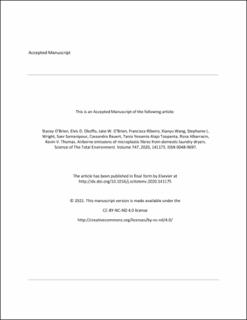| dc.contributor.author | O'Brien, Stacey | |
| dc.contributor.author | Okoffo, Elvis D. | |
| dc.contributor.author | O'Brien, Jake W. | |
| dc.contributor.author | Ribeiro, Francisca | |
| dc.contributor.author | Wang, Xianyu | |
| dc.contributor.author | Wright, Stephanie L. | |
| dc.contributor.author | Samanipour, Saer | |
| dc.contributor.author | Rauert, Cassandra | |
| dc.contributor.author | Yessenia Alajo Toapanta, Tania | |
| dc.contributor.author | Albarracin, Rizsa | |
| dc.contributor.author | Thomas, Kevin V | |
| dc.date.accessioned | 2021-07-13T14:46:48Z | |
| dc.date.available | 2021-07-13T14:46:48Z | |
| dc.date.created | 2021-03-23T14:11:30Z | |
| dc.date.issued | 2020 | |
| dc.identifier.citation | Science of the Total Environment. 2020, 747, 141175. | en_US |
| dc.identifier.issn | 0048-9697 | |
| dc.identifier.uri | https://hdl.handle.net/11250/2764315 | |
| dc.description | Embargo until 10 December 2022. | en_US |
| dc.description.abstract | An emission source of microplastics into the environment is laundering synthetic textiles and clothing. Mechanical drying as a pathway for emitting microplastics, however, is poorly understood. In this study, emissions of microplastic fibres were sampled from a domestic vented dryer to assess whether mechanical drying of synthetic textiles releases microplastic fibres into the surrounding air or are captured by the inbuilt filtration system. A blue polyester fleece blanket was repeatedly washed and dried using the ‘Normal Dry’ program of a common domestic dryer operated at temperatures between 56 and 59 °C for 20 min. Microfibres in the ambient air and during operation of the dryer were sampled and analysed using microscopy for particle quantification and characterisation followed by Fourier-Transform Infrared Spectroscopy (FTIR) and Pyrolysis Gas Chromatography-Mass Spectrometry (Pyr-GC/MS) for chemical characterisation. Blue fibres averaged 6.4 ± 9.2 fibres in the room blank (0.17 ± 0.27 fibres/m3), 8.8 ± 8.5 fibres (0.05 ± 0.05 fibres/m3) in the procedural blank and 58 ± 60 (1.6 ± 1.8 fibres/m3) in the sample. This is the first study to measure airborne emissions of microplastic fibres from mechanical drying, confirming that it is an emission source of microplastic fibres into air – particularly indoor air. | en_US |
| dc.language.iso | eng | en_US |
| dc.publisher | Elsevier | en_US |
| dc.rights | Attribution-NonCommercial-NoDerivatives 4.0 Internasjonal | * |
| dc.rights.uri | http://creativecommons.org/licenses/by-nc-nd/4.0/deed.no | * |
| dc.title | Airborne emissions of microplastic fibres from domestic laundry dryers | en_US |
| dc.type | Journal article | en_US |
| dc.type | Peer reviewed | en_US |
| dc.description.version | acceptedVersion | en_US |
| dc.source.pagenumber | 6 | en_US |
| dc.source.volume | 747 | en_US |
| dc.source.journal | Science of the Total Environment | en_US |
| dc.identifier.doi | 10.1016/j.scitotenv.2020.141175 | |
| dc.identifier.cristin | 1900271 | |
| dc.source.articlenumber | 141175 | en_US |
| cristin.ispublished | true | |
| cristin.fulltext | postprint | |
| cristin.qualitycode | 2 | |

